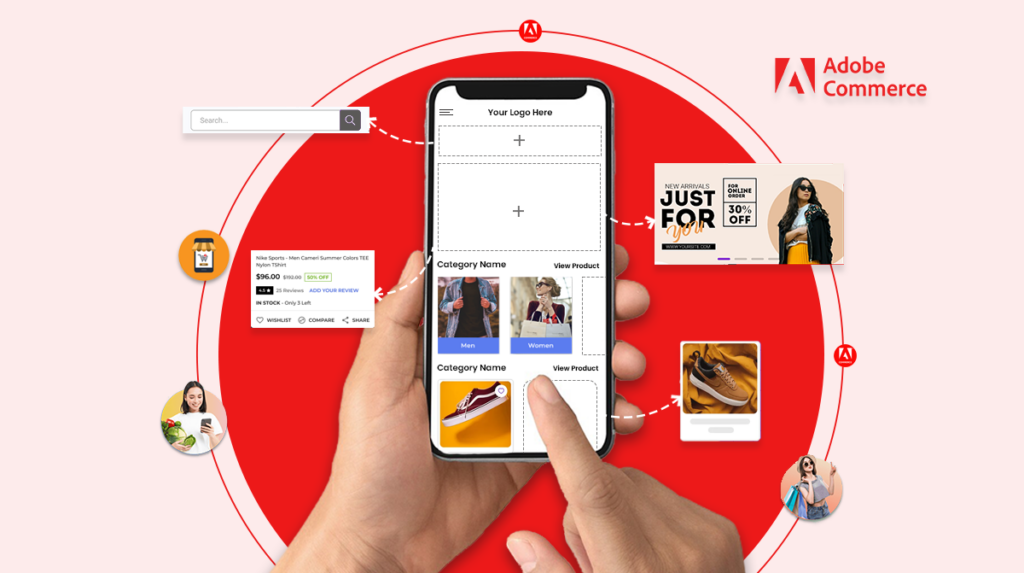Adobe Developer App Builder is a great framework that lets developers build their own cloud-native apps for Adobe Experience Cloud and Adobe Experience Platform solutions. It has one extensibility framework that can be used to get in touch with third-party systems, develop custom workflows or even create microservices along with single-page applications for business-specific needs.
App Builder is based on Adobe’s serverless architecture, I/O Runtime, which manages scalability and infrastructure management, freeing developers to focus on creating creative solutions. It provides a variety of developer tools, APIs, and services to help simplify the creation and deployment of custom apps within the Adobe Commerce Cloud ecosystem.
Modern Techniques that Help Adobe Commerce App Builder Work:
The Adobe Commerce App Builder is a platform for developing apps that are consistent, safe, and scalable, with the ability to connect with external systems. Adobe Commerce provides the opportunity to employ a wide range of tools and services, making it possible to customize, extend, and integrate the platform quickly. Partnering with an AEM development company can further enhance these capabilities, ensuring seamless integration and optimized performance. Here are some modular technologies and techniques that help in the working of Adobe Commerce App Builder:
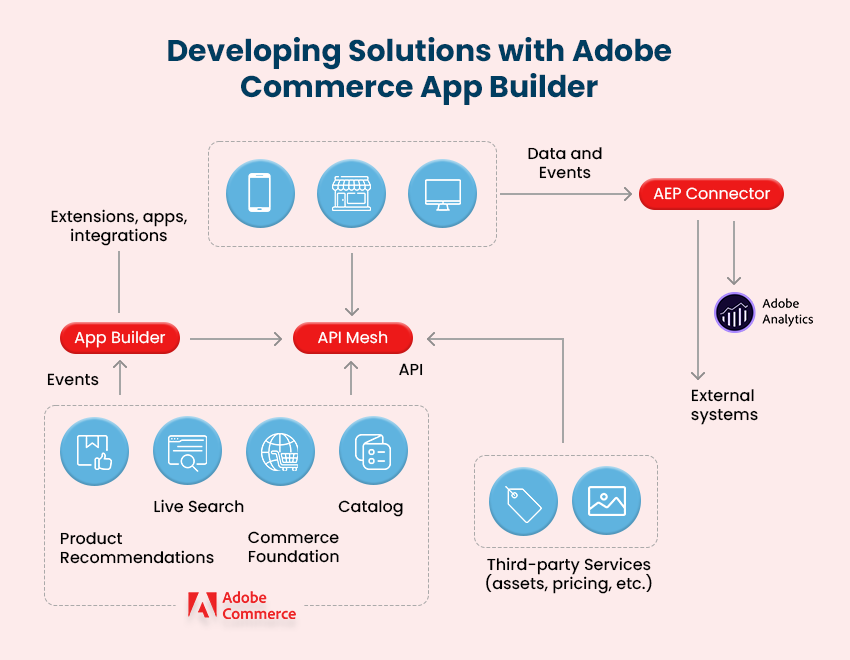
Low-Code Development
The fact that there are now low-code development platforms for e-commerce apps makes it possible for non-programmers to design apps too. It applies visual drag-and-drop interfaces, cascading templates, and pre-built components that can easily be combined to develop working apps without the need for sophisticated coding. The production process manages to be easier as a result thus leading to greater number of users being attracted to it.
Low-code platforms mainly have visual modeling features, already integrate with targeted data and facilitate integration, making it easy for developers to build and to deploy applications rapidly. It helps us to reduce time of development, the need of highly Qualified developers to come in the picture, and at the end of it, the Business executives are in position to develop applications which matches their specific needs.
Serverless Extensibility
Except for serverless architectures, there is the possibility of such an extension, regardless of controlling the infrastructure itself. In a serverless architecture, developers can devote their time to writing the code for particular operations or services as opposed to SQL to dealing with the provisioning, scaling, and maintenance of a server.
This approach has great flexibility built in, starting from scalability and ending with cost-efficiency, as only the resources will be used when they are invoked. Serverless extensibility feature resembles a modular program of argoness approach that is event-driven, a way other services can communicate and scale by themselves automatically and interfaces with other services responding to events in real-time.
API Mesh Integration
API mesh integration entails linking several APIs in a seamless and adaptable manner to form a network of linked services. This technique enables API orchestration across several systems, allowing for data interchange, communication, and collaboration across distinct applications.
Organizations can increase the overall efficiency of their systems by establishing an API mesh in App builder. Mesh API integration helps organizations manage APIs more effectively so they can create robust digital ecosystems capable of supporting various transformation initiatives.
Event-Driven Architecture
In the event-driven architecture the system design pattern comprises creation, detection, usage and the processing of events into the system. These events may be triggered by user actions, system occurrences or external influences therefore controlling data flow and activity execution across applications.
Event-driven design makes systems more responsive, scalable, and decoupled since components can react to events asynchronously. This method is ideal for real-time applications, IoT systems, and microservices architectures, where events play an important role in coordinating interactions between components.
Deployment on Adobe Infrastructure
Deployment on Adobe Infrastructure is the process of hosting and executing apps on Adobe’s cloud infrastructure. An Adobe solution partner offers a safe, scalable, and dependable platform for launching applications, websites, and services. Organizations who use Adobe’s infrastructure benefit from high availability, performance optimization, and seamless interaction with Adobe’s array of products and services.
Deploying on Adobe Infrastructure allows developers to focus on creating creative apps while trusting on Adobe’s solid infrastructure to manage the operational parts of hosting and expanding their applications efficiently.

App Builder components:
Adobe Commerce App Builder provides a unified third-party for extensibility framework for integrating and creating custom experiences. Here are some key components:
- Authentication services: Authentication services are critical for ensuring secure access to the application. Adobe Commerce App Builder has strong authentication techniques for authenticating users and granting access to various features and data within the application. This component contributes to the security of sensitive information as well as the application’s stability.
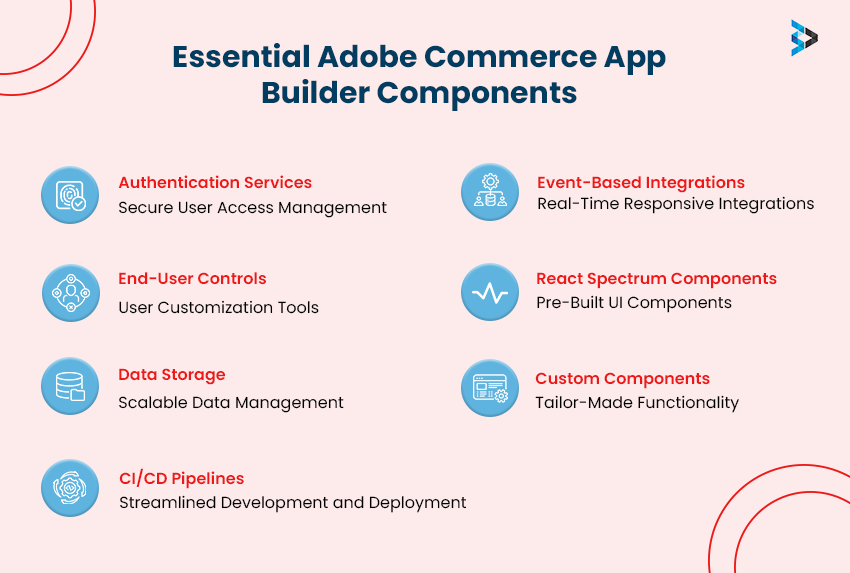
- End-User Controls: End-user controls are critical for creating an intuitive interface and improving the overall user experience. Adobe Commerce App Builder provides a variety of options to let users engage with the application efficiently. These controls enable users to browse the application, enter data, and perform activities with ease.
- Data Storage: Data storage is an essential component for storing and managing application data effectively. Adobe Commerce App Builder offers dependable data storage options, allowing developers to store, retrieve, and manipulate data efficiently. This part ensures the integrity, scalability, and speed of data which increases the program’s overall efficiency.
- CI/CD Pipelines: It assists developers in working together efficiently, and it serves to be an effective conduit for the smooth incorporation of new functions and developments. They automatically prepare builds, test them and serve the results. By integrating CI/CD pipelines into Adobe Commerce App Builder, developers enjoy improved development efficiency, enhanced code quality, and reduced release timeframes.
- Event-based Integrations: Many components of an application can communicate with each other seamlessly through event-based integrations. Event-driven architecture provided by Adobe Commerce App Builder allows developers to build applications that are scalable and responsive at the same time. This feature also supports real-time data processing, event handling as well as system integration thereby enhancing performance reliability of an application.
- React Spectrum Components: React Spectrum offers a variety of UI components that can be used to create visually attractive and dynamic experiences. For this reason, Adobe Commerce App Builder employs React Spectrum components for developing user interfaces which are engaging across different devices while remaining accessible too This element enhances design uniformity; usability as well as aesthetics within the application.
- Custom Components (Developed with Javascript, Reusable Elements, Modular Design): Custom components created using JavaScript provide flexibility and customization choices to fulfill specific needs. These reusable pieces have a modular architecture, allowing developers to enhance the functionality of Adobe Commerce App Builder and tailor the application to specific business requirements. Custom components improve the application’s scalability, maintainability, and extensibility, allowing developers to offer novel solutions.
Architecture
The Adobe Commerce App Builder’s architecture is based on a modern and adaptable design that uses Microservice Architecture concepts. This also enhances application development when it comes to providing a secure online environment for making scalable applications using flexible cloud infrastructures, seamless connectivity with Adobe Experience Cloud, and many developer tools.
Frontend
- For other backend services, the user interfaces created by Adobe Commerce’s frontend layer are interactive and captivating. These functions make development easier and enhance user experience as they use frameworks like Vue.js or React.
- Design is made responsive so that a uniform user experience is created across different types of devices like mobiles and large screens too.
- Use of Adobe Analytics Services to ensure users are provided with the extreme swiftness and functionality of an ecommerce portals.
- Tracking user interactions and behavior to gain data-driven insights.
Backend
- The application’s backend is created with Microservice Architecture, which allows for autonomous development, deployment, and scalability of services.
- Using scalable infrastructure to accommodate variable demands while maintaining good performance.
- Using a serverless environment to maximize resource efficiency and cost-effectiveness
- Backend operations and data management are seamlessly integrated on Adobe Commerce Cloud.
API Mesh
API Mesh is precisely a part of a system’s hardware logic, in a way that allows smooth integration and communication between data sources, services and applications. It sends and receives data to multiple entities which, in turn, interconnect to various data requests to be able to work smoothly and more efficiently.
Adobe Experience Cloud Products:
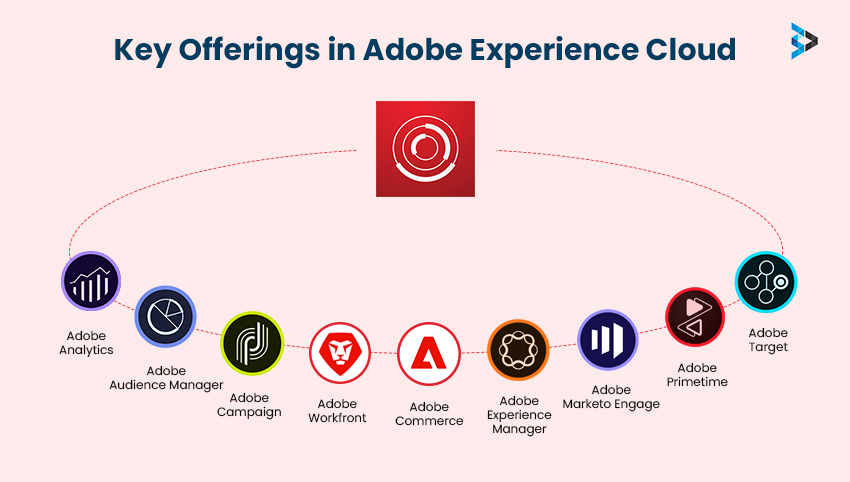
- Adobe Analytics: API Mesh partners with Adobe Analytics in order management to gather and measure data from all available sources representing clients’ interests, and this information provides insights into the psychology and preferences of users.
- Adobe Target: It adds Adobe Target integration that brings customers their custom content and personalized ideas for them.
- Adobe Campaign: API Meshes make the intercontent of Adobe Campaign less complicated which leads to providing of specific marketing campaigns and personalized messages.
Third-party APIs:
- Social Media APIs: API Mesh interlaces with social media APIs to pull data from multiple resources and collects consumer aggregated data for the purpose of building a single consumer profile.
- Payment Gateways: This embeds with payment gateways, leading to a stable and smooth flow of transactions with the utmost safety with Adobe Commerce Security.
- Customer Service APIs: API Mesh talks to customer service API thus enabling customers to experience the same interface on every channel.
Internal Systems:
- CRM Systems: API Mesh in conjunction with CRM systems can ensure that data on customers are maintained and one-version-of-truth is always in place.
- ERP Systems: It exchanges information and interoperates with other related systems including ERP for real-time stock-data monitoring and order fulfillment.
- Custom Applications: Customization of API Mesh with programs is offered to enable a constructive integration of software.
Extending Adobe Commerce with App Builder
Adobe Commerce, previously known as Magento, is an established e-commerce platform that is equipped with a vast tool set and a whole lot of things you can customize. The best and effective way to enhance Adobe Commerce capability is by using App Builder, a really advanced and easy to build software that helps create custom applications and connectors.
Middleware Extensibility:
One of the main evolutionary benefits of the usage of App Builder is that it empowers users to have dialogue with other systems and it lets them write business logic. The integration of their e-commerce system with other programs like ERP, CRM and inventory management software is a crucial prerequisite for any business seeking to run such operations.
Integrate with External Systems
- Connect Adobe Commerce with external APIs and data sources.
- Synchronize data across Adobe Commerce and other platforms.
- Automate the business operations and workflows.
Develop Custom Business Logic
- Implement customized pricing and promotion rules.
- Customize the order management and fulfillment processes.
- Integrate with third-party services and apps.
Core Services Extensibility:
Consumer trends are pivotal in shaping market strategies. GenAI enables Adobe Commerce to deliver tailored content across multiple platforms by leveraging customer data. This enhances customer satisfaction through personalized product descriptions, marketing content, norms, and recommendations.
Custom Product Data Models
- Extend the default product data model with additional properties.
- Create customized product kinds and categories.
- Integrate with external product data sources.
Modified Workflows
- Customize the order management process.
- Implement customized approval and review processes.
- Automate repetitive processes and workflows.
Customizable Pipelines
- Create customized data processing pipelines.
- Integrate with other data sources and services.
- Optimize performance and scalability.
User Experience (UI) Extensibility
Finally, App Builder has a robust set of capabilities for extending the Adobe Commerce user experience, such as bespoke admin panels and storefronts, as well as the ability to create single-page applications with the help of Adobe Experience Manager Services.
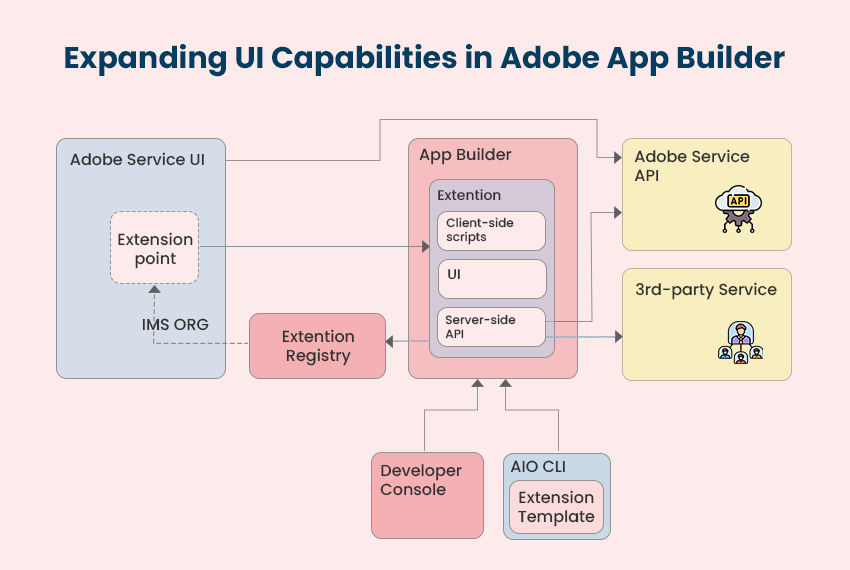
Create custom admin panels:
- Create customized administrative interfaces for specific business needs.
- Integrate with other data sources and services.
- Streamline administrative processes and workflows.
Create custom storefronts:
- Create unique and branded shopping experiences.
- Integrate with third-party design and content management solutions.
- Optimize for performance and mobile friendliness.
Single-Page Applications:
- Create extremely responsive and dynamic shops.
- Use current front-end frameworks and technologies.
- Increase user engagement and conversion rates.

Why Choose Adobe Commerce mobile app builder?
Adobe Commerce for that reason, has in the arsenal a professional-grade mobile application builder which allows organizations to have the necessary tools for creating very impressive and useful mobile applications. Expanding business’s web presence to mobile platforms with the help of useful categories, fresh interfaces and modern look and feel in adobe target solutions that are necessary for providing a positive user experience, Adobe Commerce becomes the most suitable choice. Adobe Commerce App Builder is the recommended as it has the following reasons:
| Benefit | Explanation |
| Seamless Integration with Adobe Commerce | The native app builder that integrates seamlessly with Adobe Commerce, ensures fast flow and smoothness of data transfer between the app and the e-commerce platform. It helps to keep a consistent and uniform consumer and experience. Discuss the various approaches that have been adopted to tackle the issue of overcrowding in major cities. |
| Fast Custom App Development | The Adobe Commerce mobile app developer provides a low-level or no-code way, making it super easy for developers to design and launch mobile apps, even without the need for high coding. In turn, this results in a reduction of cycle time and acceleration of the development process. |
| Personalization | The app-builder is able to interact with Adobe’s customization technologies like Adobe Target, which means that it can then send targeted messages and experiences to users they have been engaged in before and that fits their interests, which finally leads to higher engagement and loyalty. |
| Reduced Cart Abandonment | The key to lowering cart abandonment is a faster checkout process and push notifications by the mobile app, eventually resulting in higher conversion and upgrades of revenue. |
| Improved Engagement | More Meaningful Interaction Apps which are created with Adobe Commerce app builder have such features as push notifications, in-app messaging and targeted proposals which will greatly increase the audience engagement with the app and retention. |
| Omnichannel Experience | This app builder can build a harmonious omnichannel experience, which includes the mobile application linking well with online platforms and all customer contact points, thus making the purchasing process easy. |
| Streamlined Operations | The app builder’s interface with Adobe Commerce platform permits smooth mobile app management, including new versions, maintenance, and data across different devices, hence decreasing the administration burden. |
| Integration and Flexibility | Interoperability and extensibility are pivotal features of the mobile app platform, which reaches out to a broad range of third-party APIs and services, yet all seamlessly conducted through the API Mesh interface, enable organizations to personalize the mobile app to meet their separate wants and desires. |
| Simplified Platform Upgrades | Hire App Builder developer to synchronize completely with Adobe Commerce, making platform upgrades and updates are carried out on an automatic mode, thus ensuring that the mobile app is always updated with the latest features and functions. |
Read more: Adobe Commerce 2.4.7 Release – How it’s Beneficial to Your Business?
FAQs
App Builder allows for the creation of secure, scalable applications that extend Adobe Commerce’s native features and interface with third-party solutions. Developers can create new microservices, enhance core Commerce functionalities, and connect Adobe Commerce to other Adobe and third-party systems.
App Builder’s API Mesh feature enables developers to combine private or third-party APIs, as well as other software interfaces with Adobe products. This allows for the establishment of a single GraphQL endpoint to retrieve data from numerous sources, which simplifies integration with external apps.
Cart abandonment rates can be reduced by using the mobile app builder’s capabilities, such as simplified checkout processes and push alerts, which improve the entire consumer experience.
Integrating a headless commerce with Adobe Commerce helps businesses build personal connections with customers by adding an app builder to personalization facilities like Adobe Target, thus boosting engagement and devotion.
Developers may get started constructing apps with App Builder by accessing resources such as Adobe Developer App Builder documentation, tutorials, and sample code. The Adobe Solution Partner Portal also offers sandboxes for testing and development.
The App Builder enables the building of a unified omnichannel experience in which the mobile app interfaces smoothly with the e-commerce website and other customer touchpoints, resulting in a consistent and convenient buying experience.
Yes, App Builder may be used to combine Adobe Commerce with a variety of third-party systems, including as inventory management (WMS), CRM, and ERP applications, using its API Mesh and event-based integration features.
Related Articles
-
How Retail Businesses Use AEM for eCommerce and Customer Engagement
Summary: It’s 2024; your online business needs more than a working website to stand among your competitors. Besides, your ideal clients won’t waste time around slow-loading websites to complete their
-
Investing In Your Business’s Future With True Value Of Ecommerce App Development
With the increasing growth of ecommerce in the modern digital age, companies must keep up with the newest developments in this field. Many companies are turning to ecommerce app development
-
Empowering Your Business with Analytics: Making Informed Choices Using Adobe Commerce Data
Both technology and shopping trends are always in a state of constant evolution. Any company that doesn’t adapt to these changes is bound to see failure in the long run.

